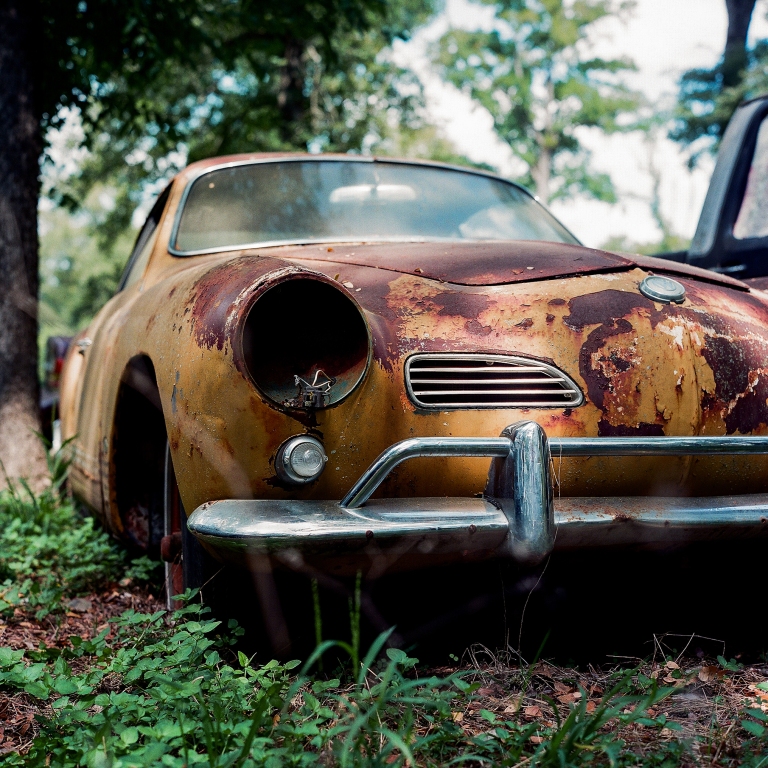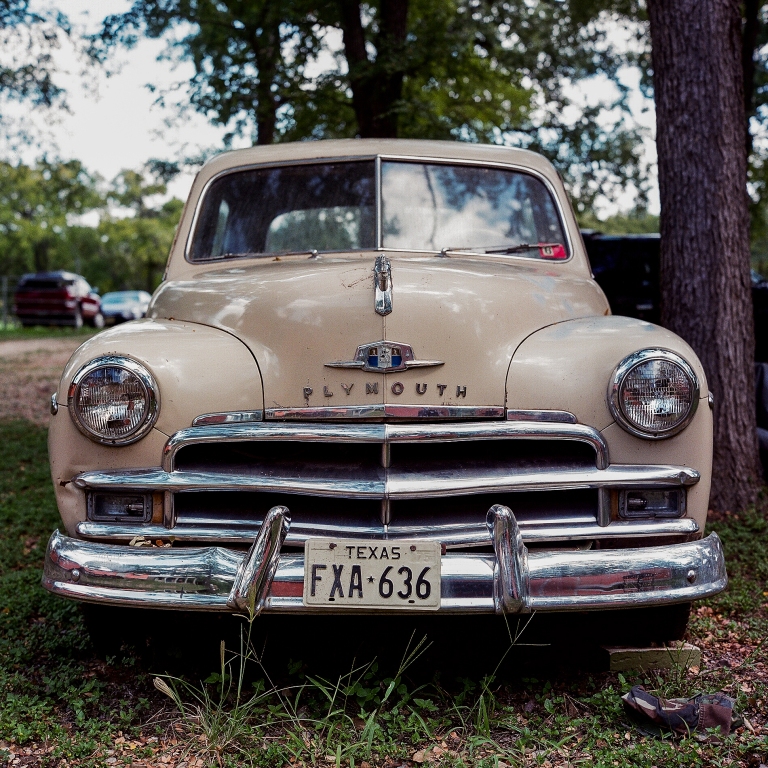John Clark has been around cars all his life. At 73 years old, he may not be interested in driving too fast with the kinds of vehicles he restores, but he has no interest in slowing down his work in his garage in Cedar Creek, Texas.
“Rust isn’t as big a problem down here,” he says. “I grew up in western Pennsylvania. I always worked on these old cars. I remember, every time I went to turn a bolt, it broke. I just fix them for myself now. I’m semi-retired. You don’t make any money fixing these up, by the time you got all the hours in and the parts prices. You never get it back.”


When John got back from Vietnam, he went to work traveling around Texas selling automotive machinery.
“Back in the 1970s, I sold frame machines to body shops and dealerships,” John says. “These great big drive-on frame machines for straightening collision damage. And, you could get in there and talk to the secretary, and if you seemed above board and on the level, the owner who might be 60 or 70 years old, an old man, would call you into his office. There would be a plush leather chair and a big fancy wooden desk, and you would sit down and talk to him. And you could sell him a $30,000 or $40,000 drive-on frame machine. Now, no way. You can’t even get in the front office. Houston was a prime example back then. They were so positive. I could load up a drive-on machine and head to Houston and have it sold that week. The dealerships down there would ask, ‘Well, what can it do, and what kind of money can it make me?’ All these other places, their first question would be, ‘Well, how much is it? $30,000? Forget it, we are not interested.’ One old guy said, ‘Son, I don’t have $30,000 of equipment in this whole building.’ Sometimes I sold them, sometimes I didn’t, but you could get in the door back then. That all changed with computers. Now, it’s all about instant gratification. It’s just black and white now, in or out. You can’t just talk to an owner anymore and convince him how your product will help his company.”

These days, John enjoys fixing cars and trucks that spark an emotional memory for him. He is currently working on a 1950 Plymouth Special Deluxe.
“This car has 28,000 original miles,” John says of his cream-colored Plymouth. “It was in one family for all these years, and their grandson took it apart to restore it and couldn’t put it back together, so I bought it from them. It’s a 1950. I will put it back together. I got it two years ago, and now I am just accumulating the parts. That’s what that other 1950 is for. It was for sale about 60 miles from here. The boy’s parents had it in their garage, and his mother says, ‘It’s been in the garage for 25 years. I wanna use my garage again.’ So, he sold it to me.”

John picked up a matching 1950 Plymouth Special Deluxe, in far worse condition, to use for the parts on his restoration project.
“The parts car had been sitting since 1972,” he says. “When I dropped the gas tank out, there was gasoline still it. You could tilt it and hear the gas still moving around. That was that leaded gas. I built a system in the garage there. I made a rotisserie to make it a lot easier. I’m not trying to hold it up and shake it. First, you put a degreaser in it and rotate it and let it sit for 24 hours, then drain that out. Then you put in this metal stuff that kills rust, and you turn it every half hour for about eight hours, then drain that and let it dry for about 96 hours. Then they got this stuff you put in called gas tank sealer. That stuff is bulletproof. You have to rotate it again, but when that cures, your problems with that tank are over. This is good for cars you can’t get a new tank for anymore.”

It is common to find an old Ford or Chevy in a garage these days, being brought back to their former glory. Plymouths, however, are not such a common find. But, John has a connection to these old “boats” as he calls them.
“My dad had a Plymouth like this for a work car back in the early 60s,” he explains. “We took that car everywhere. One time, my dad and my brother were out hunting, they were up in the mountains, and they came to a dead end and they couldn’t get turned around to go back. My brother said, ‘Hey dad, there’s the road down there.’ And he said, ‘Okay, go on down.’ ‘But, there’s no road,’ my brother said to him. ‘That’s alright,’ my dad told him. And they just took the old Plymouth right down the side of the mountain and up on the old road where they needed to be. My brother and I learned to drive on that car and it was bulletproof. That was a 1951. He got it in 1963. It was seafoam green. Basically the same car as I have here with a different grill. My dad’s name was Frank. He was one of those guys who wanted to enlist in WWII and they wouldn’t let him because he worked in the steel mill in western Pennsylvania. So, they said, ‘Nope, you’re not going anywhere. We need you to keep cranking out that steel.’ So, my uncle went to war and dad didn’t.”
“These cars had 97 horsepower in the flathead six,” John continues. “Their top speed was about 75 mph. Military used those for staff cars, and one of their requirements was that it had to be reliable at 70 mph for substantial lengths of time. A general might have used that, if they couldn’t get him a Packard. If they could get a Packard, that’s what he wanted. Unfortunately, an old Plymouth like this isn’t worth much now. And that’s the extended length model. It’s a Special Deluxe, the top-of-the-line. But, everybody wants the old Fords and Chevys now, because that’s what they grew up with.”

John’s pride and joy, as a Vietnam veteran and a member of the Military Vehicle Preservation Association, is his Jeep. He spent years restoring the military Jeep as a tribute to his uncle and WWII veteran, John K. Clark.



“That’s a Vietnam-era M151A2,” John says. “This is a 1967. This is what’s called a marine Jeep. And this one is a true Vietnam veteran. The reason it’s a marine Jeep is because they put these loops on them so they could tie them to pallets and shove them out of airplanes. And this rascal had been dropped a few times. There wasn’t a straight panel on it when I got it. This took a lot of time, a lot of years. This is a tribute Jeep. The number on the bumper is my uncle’s marine service ID number. He was in WWII in the South Pacific. This is a Vietnam-era Jeep, but it is a Tribute to my uncle. It’s the best of both worlds, because I wanted to do a tribute to him, but I was in the Air Force, and this a marine Jeep, and I didn’t want to change it. I was in Vietnam and this is a Jeep from that era.”
“This is supposed to be the best Jeep ever made, the M151A2,” he says. “This is a unibody, like our later model cars. It’s got a four-wheel independent suspension. The guys really didn’t know how to drive the first ones, and a lot of guys got killed. They would sit level at higher speeds until it was too late. Once it started rolling, it was done. The guys would roll them and get killed. So, the military quit selling them to civilians. What they would do is they would cut them up into quarters because of the liability factors. This one here has the improvements they made to eliminate the rollover problems.”

“People really enjoy this Jeep,” John says with pride. “But, top speed is about 60, and then it sounds like it’s going to come apart, so you normally drive it about 50, and people don’t like to slow down. If they’re in a hurry, I’m just in there way. But, it depends. If the guy’s a veteran, you don’t have a problem. If he is not a veteran, it’s, ‘What’s that old thing holding me up for?!’ Everybody loves that Jeep. They say, ‘You did a fantastic job,’ but I think it’s something else. Maybe it is because it is a tribute Jeep to a WWII veteran.”

“A company called Bantam Motor Company out of Butler, Pennsylvania actually designed the first Jeep,” John explains. “The government didn’t think they were a big enough company to produce enough Jeeps, so they lent the plans out to Ford and Willys. The next one I’m going to redo is that 1948 CJ-2A. That’s a civilian model. But, that is basically the old military Jeep. What happened was, when the guys would come home from the service, they wanted their old Jeeps, and Willys said, ‘Heck, let’s start making a civilian model.’ So, this is the civilian model. They started them in 1946, I think. That’s a 1948. They all looked the same. You couldn’t tell the difference. You don’t see many of them anymore. I’m going to redo that one soon.”
John enjoys his hobby and being around the cars and trucks that remind him of his family and the memories he has of growing up around a family with a love for cars.
“Back when I was younger, I couldn’t afford any old cars,” he says. “Now, I’ve got lots of them to play with.”
They remind him of a simpler time, a friendlier time.
“Back in the 60s and 70s, people were really friendly down here,” John says of his Texas life. “If you were on a two-lane road and there was room to move over, a guy would move over and let you go on your way. And he would wave. Now when they wave, it’s that one-finger salute.”
